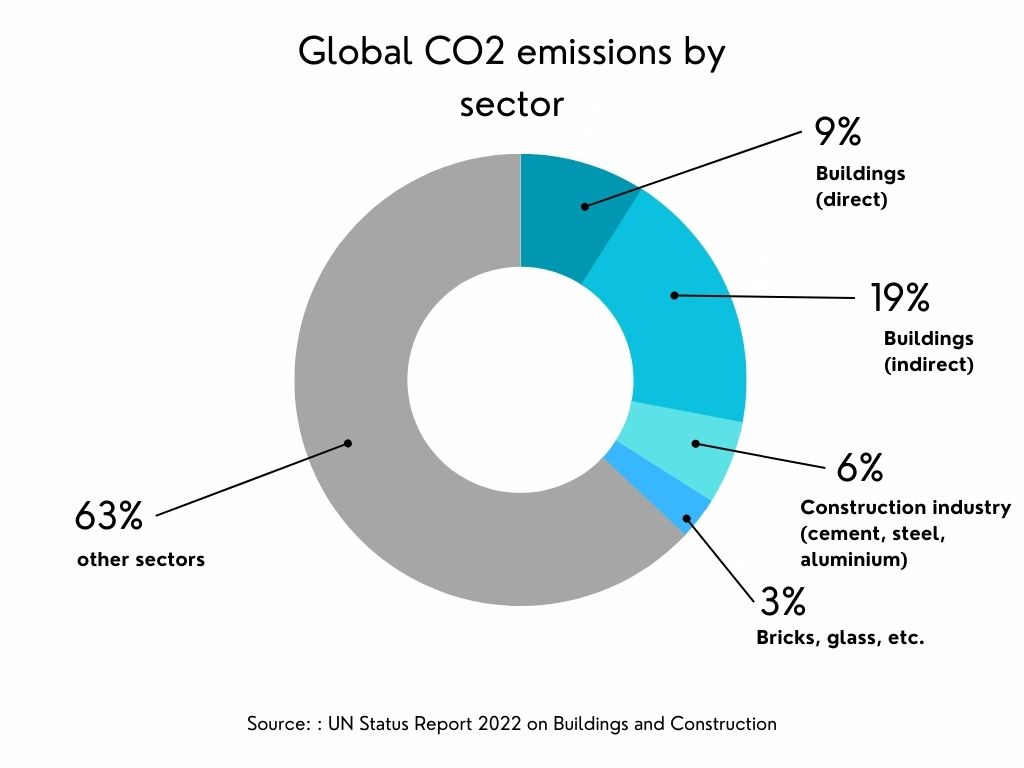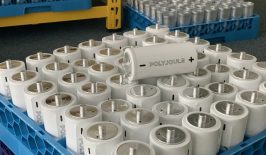A house as a self-regulating ecosystem, supplying itself with energy, cooling rooms in summer and warming them in winter. A house that changes with the needs of its inhabitants and in whose greenery animals find a home. And which, integrated into a network with neighbouring houses, shares and stores communal heat and energy. When it is no longer needed, its components become sustainable building material for new houses or compost themselves.
Is this what the sustainable buildings of the future will look like?
Why we need to rethink buildings
Climate change presents us with major challenges. On the one hand, we need to radically reduce our CO2 emissions to stop our planet from heating up further. At the same time, we must become more resilient to the effects that are already being felt.
CO2 emissions will only go down if, in addition to the energy, mobility and agricultural transformation, the CO2 footprint of our buildings shrinks to a new, lower level. Alongside industry and transport, the building sector is one of the largest consumers of energy in Europe. The majority of this energy consumption — around 90 percent — goes into heating and hot water production — and this is still based on fossil primary energy such as gas and oil. A third of this final energy demand is caused by non-residential buildings and two-thirds by residential buildings.
CO2 emissions increase even further if all upstream chains are also included, i.e. the emissions caused by the production of building materials, plant technology and the construction itself. This means that buildings in the EU are responsible for 40 percent of our energy consumption and 36 percent of greenhouse gas emissions — and the picture is similar worldwide. In addition, the building sector in Germany is responsible for almost half of the national waste volume.
What these figures make clear is that the building sector is an emissions-intensive heavyweight that must massively reduce its ecological footprint in order to achieve the climate targets.
Major transformations are on the horizon in the building sector
According to the EU Buildings Directive (EPBD), all new buildings are to be emission-free from 2028. For new buildings used, operated or owned by public authorities, this should even apply from 2026. Existing buildings are to gradually become zero-emission buildings by 2050.
However, the EU Parliament’s decision is not yet binding; the final form of the European directive is still being determined. But whatever the concrete wording of the buildings directive will be — the sooner CO2 emissions in the building sector are reduced, the better. The deadline to achieving our climate target is fast approaching.
So, where to start with this transformation? The EU has a very large building stock that still has too high of a heat demand, despite partial energy refurbishment. At the same time, our houses can potentially last for centuries. Therefore, energy consumption in the use phase is an essential adjusting screw to the reduction of emissions in the sector. The biggest lever here is the energy refurbishment of existing buildings, as this means that less energy has to be used for heating and cooling. In addition, heat pumps are central technology with regard to heating buildings in almost all of the climate neutrality scenarios presented here. In urban areas, the densification of existing heating networks and comprehensive solutions at neighbourhood level are also essential.
Buildings are a CO2 heavyweight: the construction, heating, cooling and disposal of our homes accounts for around 40 percent of Germany’s CO2 emissions. We will only achieve our climate goals if these emissions are massively reduced.
But how can we achieve the sustainable transformation of buildings and what role do digital solutions play in this? The RESET Greenbook provides answers: Building transformation – intelligently transforming houses and neighbourhoods.
In order to achieve climate neutrality in Europe, it is vital to focus not only on the operating phase of buildings, but also on the creation of new buildings. It is important to reduce all emissions in the life cycle of a building, from the production of the building materials, the construction itself, the repairs, the renovation and the demolition or dismantling.
New materials and processes are also in demand, as well as the revival of familiar ones. “Millennium-old buildings made of clay, as in Yemen or West Africa, are sustainable and vernacular, i.e. adapted to the regional requirements of a place. The concrete of ancient Rome was also fired with much less heat than modern concrete, and is much stronger and more durable. When we build skyscrapers, their construction and material must also result from the climatic and geographical conditions. With future technology, we may see ‘living’ skyscrapers, made of materials like clay or mycelium, i.e. mushroom threads,” says Hubert Klumpner, professor of architecture and urban planning at ETH Zurich and founder of the Urbanthinktank_next office.
In addition, it is urgently necessary that the materials used in construction become recyclable, because currently only just under seven percent of the waste generated in the building sector is recycled.
Renewable energies and digitalisation make new types of buildings possible
Within the primarily centralised energy systems of the past, buildings were seen primarily as consumers of heat and electricity. But with the energy transition and new, decentralised supply and generation structures – such as photovoltaics, solar thermal and heat pumps – this is changing. And with electromobility, new types of batteries and storage solutions, buildings are also becoming producers and self-suppliers.
In addition, there is another development: the progressive digitalisation of the energy system and the building sector, from smart electricity meters to smart home and smart building solutions.
Digital building technologies are understood to be various applications that reduce the energy consumption or emissions of buildings along their life cycle. These can be, for example, digital solutions that support sustainable planning in the construction phase, control energy consumption in the use phase or enable new types of sharing approaches or help with the return of materials during demolition. The digitisation of data and access to different data sets also has the potential to better measure and understand the building sector in terms of its impact on the climate, to derive concrete solution strategies and to measure progress.
The potential of digital technologies for a more sustainable building sector could well be great. For example, Simon Hinterholzer and Severin Beucker of the Borderstep Institute assume in the study “Climate Protection and Energy Efficiency through Digital Building Technologies” that
“an ambitious expansion of building automation alone can save up to 14.7 million tonnes of CO2 emissions in the building sector in the short to medium term (2030).”
This would make almost 30 percent of the reduction target for the building sector formulated in the Climate Protection Act. At the same time, the awkward truth is that digital technologies also consume a large amount of energy and resources in production and training, as well as in operation and disposal. Therefore, from a sustainability perspective, the question of the use of digital technologies in the building sector is a complicated one. Watch this space as we delve deeper into the topic of digital solutions regarding sustainable buildings.










